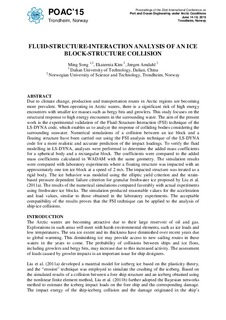Fluid-structure-interaction analysis of an ice block-structure collision
Journal article, Peer reviewed
Published version
Permanent lenke
http://hdl.handle.net/11250/2468721Utgivelsesdato
2015Metadata
Vis full innførselSamlinger
- Institutt for marin teknikk [3406]
- Publikasjoner fra CRIStin - NTNU [37247]
Originalversjon
Proceedings - International Conference on Port and Ocean Engineering under Arctic Conditions. 2015, 2015-January .Sammendrag
Due to climate change, production and transportation routes in Arctic regions are becoming more prevalent. When operating in Arctic waters, there is a significant risk of high energy encounters with smaller ice masses such as bergy bits and growlers. This study focuses on the structural response to high energy encounters in the surrounding water. The aim of the present work is the experimental validation of the Fluid-Structure-Interaction (FSI) technique of the LS-DYNA code, which enables us to analyze the response of colliding bodies considering the surrounding seawater. Numerical simulations of a collision between an ice block and a floating structure have been carried out using the FSI analysis technique of the LS-DYNA code for a more realistic and accurate prediction of the impact loadings. To verify the fluid modelling in LS-DYNA, analyses were performed to determine the added mass coefficients for a spherical body and a rectangular block. The coefficients were compared to the added mass coefficients calculated in WADAM with the same geometry. The simulation results were compared with laboratory experiments where a floating structure was impacted with an approximately one ton ice block at a speed of 2 m/s. The impacted structure was treated as a rigid body. The ice behavior was modeled using the elliptic yield criterion and the strainbased pressure dependent failure criterion for granular freshwater ice proposed by Liu et al. (2011a). The results of the numerical simulations compared favorably with actual experiments using freshwater ice blocks. The simulation produced reasonable values for the acceleration and load values, similar to those obtained in the laboratory experiments. The acceptable compatibility of the results proves that the FSI technique can be applied to the analysis of ship-ice collisions.
